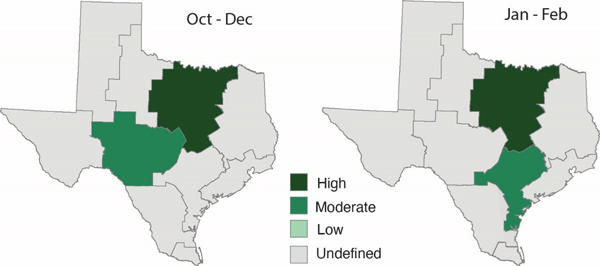Over the last ten years, stripe rust has been one of the most damaging wheat diseases in Kansas. Several factors contribute to the development and severity of stripe rust in our region within a given year. The stripe rust pathogen typically does not survive in Kansas over the winter but can survive in Texas through the winter months and make its way back north as the weather warms in the spring. Because of this, weather conditions in Texas in the fall and early spring can be important predictors of how bad stripe rust will be in Kansas.
This year, the first stripe rust report we received was from Chillicothe, TX, on January 31, where the disease was starting to take hold. Reports indicated that stripe rust was still active there and in McGregor, TX, in late February. On March 8, moderate to high levels of stripe and leaf rust were reported in wheat breeding nurseries in Castroville, TX (just outside San Antonio). To date, there have been no detections in Kansas yet in 2024. Historically, detections in Kansas before April 15 have been associated with bad stripe rust years. Scouting efforts over the next few weeks will be very important.
How did winter weather look for stripe rust in Texas?
A look at the moisture patterns for 2023-24 indicates there was moderate/high moisture in Texas in the fall (map on the left in Figure 1), which may have been favorable for rust development. This pattern of moderate/high moisture has continued through the early spring, which has likely promoted stripe rust sporulation and spread.

Figure 1. K-State research has shown that the annual severity of stripe rust outbreaks in Kansas can be predicted by soil moisture in key regions of Texas in both the fall and the early spring. In the fall of 2023, soil moisture in Texas was moderate to high (indicated by medium/dark green colors on the map). In Jan-Feb 2024, there was also high moisture in some of these key regions of Texas. These maps show soil moisture levels based on the “Palmer Z-Index” provided by NOAA-National Centers for Environmental Information.
What does this mean for Kansas wheat?
Early reports of high levels of stripe rust in Texas, along with favorable weather in Texas in the fall and spring, are early indicators that we could have a stripe rust issue in Kansas in 2024. Historically, years that begin like this have ended with high yield losses in Kansas due to this disease. Of course, stripe rust severity in Kansas is still largely driven by weather conditions in the state in the late spring and the varieties planted. Once stripe rust is detected in Kansas, cool evenings and extended periods of canopy moisture will be necessary for disease establishment at levels that would result in yield loss. If the weather turns hot and dry quickly, stripe rust will have fewer opportunities to take hold.
The disease situation can change rapidly, and it is important to continue to scout for signs of disease development as the season progresses. We will continue to provide updates on stripe rust occurrence and weather outlook as we move toward critical growth stages for fungicide applications in Kansas over the next several weeks.
If considering fungicide applications, please see the article in this issue titled Considerations for Early Fungicide Applications on Wheat in 2024.
Please contact us (andersenk@ksu.edu) if you detect stripe rust in Kansas so we can update regional maps.
Kelsey Andersen Onofre, Extension Plant Pathologist
andersenk@ksu.edu
785-410-2426 (m)
Erick De Wolf, Plant Pathologist
dewolf1@ksu.edu
Tags: wheat disease outlook stripe rust